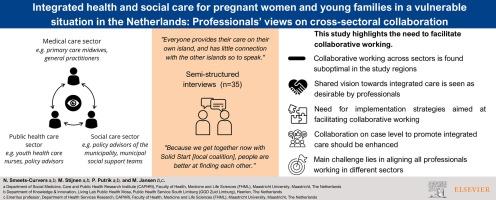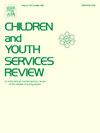Integrated health and social care for pregnant women and young families in a vulnerable situation in the Netherlands: Professionals’ views on cross-sectoral collaboration
IF 2.4
2区 社会学
Q1 FAMILY STUDIES
引用次数: 0
Abstract
Purpose
This qualitative study investigated the perspective of professionals from the medical, social, and public health care sectors with regard to: cross-sectoral collaboration in providing integrated health and social care during the first thousand days of life (preconception up to children aged two years) for pregnant women and young families in a vulnerable situation. This knowledge is needed for the enhancement of cross-sectoral collaboration and the implementation of integrated care.
Methods
Professionals (n = 35) were recruited from three deprived municipalities in South-Limburg, the Netherlands. Semi-structured interviews gained insight into professionals’ views, by using a theoretical framework based on the ‘National model for integrated care for childhood overweight and obesity’.
Results
Professionals stressed the importance of addressing both medical and social risk factors in pregnant women and young families in a vulnerable situation. However, their interpretation of vulnerability differed, hindering collaborative working. Furthermore, cross-sectoral collaboration was restricted by lack of formal cooperation agreements between sectors, and unclear referral lines from the medical to the social sector. Professionals often did not know the expertise and role of other sectors. Digital information and referral systems are not connected between the sectors which acts as an inhibiting factor.
Discussion/Conclusion
This study highlights the need and ways to facilitate collaborative working between the medical, social, and public health care sectors in delivering integrated care. Recommendations include: 1) Enforcing implementation strategies aimed at facilitating collaborative working: formal regulations, structured agreements, and use of consistent definitions and protocols to facilitate integration; 2) Strengthen informal connections between professionals by the Solid Start local coalitions; 3) Align all professionals, also those not directly involved in the Solid Start local coalition, with the goals and vision of the coalition; 4) Implement a joint digital file or IT referral system to improve cross-sectoral collaboration; 5) Enhance collaboration between sectors at case level through multidisciplinary consultation.

为荷兰处于弱势的孕妇和年轻家庭提供综合医疗和社会关怀:专业人员对跨部门合作的看法
目的 本定性研究调查了来自医疗、社会和公共卫生保健部门的专业人员对以下问题的看法:在生命的头一千天(受孕前至两岁儿童),为处于弱势的孕妇和年轻家庭提供综合医疗和社会保健方面的跨部门合作。从荷兰南林堡的三个贫困市镇招募了专业人员(35 人)。结果专业人员强调了解决处于弱势的孕妇和年轻家庭的医疗和社会风险因素的重要性。然而,他们对脆弱性的解释却不尽相同,从而阻碍了合作。此外,由于各部门之间缺乏正式的合作协议,以及从医疗部门到社会部门的转诊路线不明确,跨部门合作受到了限制。专业人员往往不了解其他部门的专业知识和作用。讨论/结论 本研究强调了促进医疗、社会和公共卫生保健部门在提供综合护理方面开展合作的必要性和方法。建议包括1)执行旨在促进合作的实施策略:正式规定、结构化协议、使用一致的定义和协议,以促进整合;2)通过 "扎实起步 "地方联盟加强专业人员之间的非正式联系;3)使所有专业人员(包括未直接参与 "扎实起步 "地方联盟的人员)与联盟的目标和愿景保持一致;4)实施联合数字档案或信息技术转介系统,以改善跨部门合作;5)通过多学科咨询,在病例层面加强各部门之间的合作。
本文章由计算机程序翻译,如有差异,请以英文原文为准。
求助全文
约1分钟内获得全文
求助全文
来源期刊

Children and Youth Services Review
Multiple-
CiteScore
6.30
自引率
6.10%
发文量
303
期刊介绍:
Children and Youth Services Review is an interdisciplinary forum for critical scholarship regarding service programs for children and youth. The journal will publish full-length articles, current research and policy notes, and book reviews.
 求助内容:
求助内容: 应助结果提醒方式:
应助结果提醒方式:


